|
Size: 11218
Comment:
|
Size: 14449
Comment:
|
| Deletions are marked like this. | Additions are marked like this. |
| Line 2: | Line 2: |
| '''[TUTORIAL UNDER DEVELOPMENT: NOT READY FOR PUBLIC USE]''' | ''Authors: [[https://neuroimage.usc.edu/brainstorm/AboutUs/tmedani|Takfarinas Medani]], Juan Garcia-Prieto, Francois Tadel, Sophie Schrader, Anand Joshi, Christian Engwer, Carsten Wolters, John Mosher and Richard Leahy '' |
| Line 4: | Line 4: |
| ''Authors: Takfarinas Medani & Juan Garcia-Prieto''''' ''' | {{attachment:logo_duneuro.png||align="right",height="82",width="187"}} |
| Line 6: | Line 6: |
| This tutorial explains how to use brainstorm-dueneuro to compute the forward model using the finite element method (FEM). | This tutorial explains how to use [[https://www.medizin.uni-muenster.de/duneuro/startseite.html|DUNEuro]] to compute the forward model using the '''finite element method''' ('''FEM'''). The FEM methods use a realistic volume mesh of the head generated from the segmentation of the MRI. The FEM models provide more accurate results than the spherical forward models and more realistic geometry and tissue properties than the [[Tutorials/TutBem|BEM]] methods. Its applications include accurate source localization in MEG/EEG/sEEG/ECoG and TMS/TDCS optimizations. |
| Line 8: | Line 8: |
| This forward model uses the FEM method implemented within the [[http://duneuro.org/|Duneuro]]''' '''software. More documentation could be found on this''' '''[[https://gitlab.dune-project.org/duneuro/duneuro/wikis/home|page]]'''. ''' | The scope of this page is limited to a '''basic example''' (head model with 3 layers). More advanced options for mesh generation and forward model computation are discussed in other tutorials: [[Tutorials/FemMesh|FEM mesh generation]], [[Tutorials/FemTensors|FEM tensors estimation]], [[Tutorials/FemMedianNerve|FEM median nerve example]]. We assume that you have already followed the [[Tutorials|introduction tutorials]], we will not discuss the general principles of forward modeling here. |
| Line 10: | Line 10: |
| The FEM methods use the realistic volume mesh of the head model generated from the segmentation of the magnetic resonance images (MRI). The FEM forward solution provides more accurate results than the spherical models and more realistic geometry and tissue propriety than the [[https://neuroimage.usc.edu/brainstorm/Tutorials/TutBem?highlight=%28bem%29|BEM]]. ''In this tutorial, we will describe the softwares required to use the DUNEuro computation from brainstorm and a basic examples on the FEM computation through the graphical interface. '' |
<<TableOfContents(2,2)>> |
| Line 15: | Line 13: |
| '''[[http://duneuro.org/|DUNEuro]] '''is an open-source C++ software library for solving partial differential equations (PDE) in neurosciences using mesh bases methods. It is based on the''' [[https://www.dune-project.org/|DUNE library]] '''and its main features that include solving the electroencephalography (EEG) and magnetoencephalography (MEG) forward problem and providing simulations for brain stimulation. <<BR>> ''' {{attachment:duneuroFromDune.JPG||height="240",width="700"}} ''' '''<<BR>>''' | '''[[https://www.medizin.uni-muenster.de/duneuro/startseite.html|DUNEuro]] '''is an open-source C++ software library for solving partial differential equations (PDE) in neurosciences using mesh-based methods. It is based on the''' [[https://www.dune-project.org/|DUNE library]] '''and its main features include solving the EEG and MEG forward problem and providing simulations for brain stimulation. |
| Line 17: | Line 15: |
| == Citing DUNEuro and Brainstorm-Duneuro == Please cite the following papers if you use this software tool or its derivatives in your own work. |
As distributed on the [[http://gitlab.dune-project.org/duneuro/duneuro|DUNEuro GitLab]], the source code works only on Linux operating systems. Interfaces to Matlab and Python are possible, but you need to install and compile DUNEuro by yourself. For Brainstorm, we adapted this code and were able to generate '''binaries''' for the main operating systems''' '''(Windows, '''Linux '''and MacOS), which are '''downloaded automatically''' when needed as a [[Tutorials/Plugins|Brainstorm plugin]]. This project is available on our [[https://github.com/brainstorm-tools/bst-duneuro|GitHub repository bst-duneuro]]. |
| Line 20: | Line 17: |
| Andreas Nüßing, Maria Carla Piastra, Sophie Schrader, Tuuli Miinalainen, Sampsa Pursiainen, Heinrich Brinck, Carsten H. Wolters, Christian Engwer | We would like to thank the''' DUNEuro team '''for their help with this integration work: Carsten Wolters, Christian Engwer, Sophie Schrader, Andreas Nuessing, Tim Erdbruegger, Marios Antonakakis, Johannes Vorwerk & Maria Carla Piastra. |
| Line 22: | Line 19: |
| ''"duneuro - A software toolbox for forward modeling in neuroscience"'' under review | ''' {{attachment:duneuroFromDune.JPG||height="187",width="546"}} ''' |
| Line 24: | Line 21: |
| ''"The Brainstrom-Duneuro: friendly interface for the EEG/MEG with the Finite Element Method"'' | If you use Brainstorm-DUNEuro please '''cite the following papers''' in your work: |
| Line 26: | Line 23: |
| underwriting | * Schrader, S., Westhoff, A., Piastra, M.C., Miinalainen, T., Pursiainen, S.,Vorwerk, J., Brinck, H., Wolters, C.H., Engwer, C., DUNEuro- A software toolbox for forward modeling in bioelectromagnetism, PLoS ONE, 16(6):e0252431 (2021). doi: [[https://urldefense.com/v3/__https://doi.org/10.1371/journal.pone.0252431__;!!LIr3w8kk_Xxm!-bMXySp_3t41y5-tXZHEiMKGFE32SAMz93NulthzqfHf4uA7QstTC15r64oFpQ$|https://doi.org/10.1371/journal.pone.0252431]] * Medani, T., Garcia-Prieto, J., Tadel, F., Schrader, S. Antonakakis, M., Joshi, A., Engwer, C., Wolters, C.H., Mosher, J., Leahy, R., "Realistic head modeling of electromagnetic brain activity: an integrated Brainstorm-DUNEuro pipeline from MRI data to the FEM solutions," Proc. SPIE 11595, Medical Imaging 2021: Physics of Medical Imaging, 1159554 (15 February 2021);https://doi.org/10.1117/12.2580935 |
| Line 28: | Line 26: |
| == Software requirements == === FEM Computation : DUNEuro === In order to use the FEM computation, Brainstorm calls the DUNEuro Th DUNEuro binaries are distributed within the [[https://github.com/brainstorm-tools/bst-duneuro|bst-duneuro toolbox]]. These binaries are adapted and tested for Windows, MAC, and Linux 64bit systems. Therefore you don't need to install any extra software package to run the FEM computation, brainstorm will do it for you and install it in Brainstorm user folder (~username/.brainstorm/bst-duneuro/) |
If you want to learn more about DUNEuro, please visit to the following web pages: |
| Line 32: | Line 28: |
| === FEM mesh : software and toolbox === In order to use the FEM computation of the electromagnetic field (EEG/MEG), the volume mesh of the head is required. Brainstorm integrates most of the modern open-source tools used to generate realistic head mesh, either from nested surface mesh or from individual MR image (T1 or T1 and T2). |
* [[https://www.medizin.uni-muenster.de/duneuro/forschung.html|DUNEuro main website]] * [[https://www.medizin.uni-muenster.de/duneuro/forschung.html|DUNEuro publications]] |
| Line 35: | Line 31: |
| The minimal requirement for FEM mesh generation is the [[http://iso2mesh.sourceforge.net/cgi-bin/index.cgi?Download|iso2mesh]] toolbox. For advanced mesh, the list of the available methods are listed and explained in [[https://neuroimage.usc.edu/brainstorm/meshGeneration#preview|this tutorial]]'''. ''' | == Requirements == In order to reproduce the computation present below on your computer, you need to fulfill all the conditions listed below. Alternatively, you can read this page as a reference documentation about DUNEuro and not try to reproduce the results. |
| Line 37: | Line 34: |
| New methods are under development and will be released to brainstorm in the next future. | * You have a working copy of Brainstorm installed on your computer. * You have already followed the [[https://neuroimage.usc.edu/brainstorm/Introduction|introduction tutorials]], at least until #23. * You have followed the tutorial [[https://neuroimage.usc.edu/brainstorm/Tutorials/Epilepsy|EEG and Epilepsy]], as it is used for illustrating the computation. * '''DUNEuro''': Software installed automatically as a [[https://neuroimage.usc.edu/brainstorm/Tutorials/Plugins|Brainstorm plugin]]. * '''Iso2mesh''': Software installed automatically as a [[https://neuroimage.usc.edu/brainstorm/Tutorials/Plugins|Brainstorm plugin]]. |
| Line 39: | Line 40: |
| The FEM mesh visualization and mesh processing option are integrated with brainstorm. The use of these options requires also the installation of the [[http://iso2mesh.sourceforge.net/cgi-bin/index.cgi?Download|iso2mesh]]'''. ''' | == FEM mesh == In order to use the FEM computations of the electromagnetic field (EEG/MEG), the volume mesh of the head is required. Brainstorm integrates most of the modern open-source tools to generate realistic head mesh, either from nested surface mesh or from individual MR images (T1 or T1 and T2). This tutorial describes only a simple approach based on three nested surfaces meshed in 3D with Iso2mesh. For the full list of available methods and description of options, please refer to the tutorial [[https://neuroimage.usc.edu/brainstorm/Tutorials/FemMesh|FEM mesh generation]].''' ''' |
| Line 41: | Line 43: |
| Brainstrom will download the last release from this [[https://neuroimage.usc.edu/brainstorm/http://iso2mesh.sourceforge.net/cgi-bin/index.cgi?Download|webpage]]''' '''and install it when it is needed. However, you can also download the iso2mesh from the''' '''[[https://github.com/fangq/iso2mesh|github]]''' '''and add it to your Matlab path. | * Select the protocol TutorialEpilepsy, created while following the tutorial [[http://Tutorials/Epilepsy|EEG and epilepsy]]. * Go to the anatomy view. * Select the three [[https://neuroimage.usc.edu/brainstorm/Tutorials/TutBem#BEM_surfaces|BEM surfaces]]: scalp, outer skull, inner skull. * Right-click > '''Generate FEM mesh''' > Iso2mesh-2021 > MergeMesh > Default options. <<BR>><<BR>> {{attachment:femMesh1.gif}} <<BR>> {{attachment:iso2mesh.gif}} ''' ''' * The FEM mesh appears in the database explorer after a short while. The first number indicates the number of vertices (i.e. nodes) of the tetrahedral mesh. To get the number of 3D elements (i.e. tetrahedrons) in this geometric model of the head: right-click on the file > File > View file contents. The structure of the file is describe in the tutorial [[https://neuroimage.usc.edu/brainstorm/Tutorials/FemMesh#On_the_hard_drive|FEM mesh generation]].<<BR>><<BR>> {{attachment:femMesh2.gif}} * Double-click on the FEM file to display it. From the Surface tab, you can change the resection locations by moving the bottom sliders, and you can control the display of each of the three layers individually. Click on the layer button in the toolbar, then adjust the color and transparency of the corresponding mesh. The figure below represents the FEM mesh in the center and the initial BEM layers on the right. <<BR>><<BR>> {{attachment:femMesh3.gif}} |
| Line 43: | Line 50: |
| === FEM and tissue anisotropy : Brainsuite === Among the advantages of the FEM, the use of tissue anisotropy (conductivity). The estimation of the tissue anisotropy is performed with the Brainsuite diffusion pipeline (BDP link). The diffusion tensor images are estimated with Brainsuite and then converted to conductivity tensor using the Tuch. In order to use this option, you need to install Brainsuite software, the rest of the process is distributed within bst-duneuro.'''<<BR>>'''<<TAG(Advanced)>>''' <<BR>> ''' |
== FEM forward model == The '''forward model''' (or '''head model''' in the Brainstorm documentation and interface) describes how the electric activity in the '''source space''' (the cortex surface or a regular grid of volume points) influences the electric potential (EEG) or magnetic fields (MEG) at the level of the '''sensors'''. The FEM method uses the '''tetrahedral mesh''' computed above to establish this relationship. ''' ''' |
| Line 46: | Line 53: |
| * DUNEuro software is built on top of the DUNE Library. The Duneuro [[https://gitlab.dune-project.org/duneuro/duneuro|source code]] works only on Linux operating systems. However, we were able to generate the binaries for the main platforms (Windows 64, Linux and Mac), thus, it can be easily used from brainstorm and Matlab without the need to install and compile the tedious Dune and Duneuro libraries on your computer. * The main process of the Duneuro compilation used for brainstorm is explained [[https://github.com/brainstorm-tools/bst-duneuro|here]] |
* Go the Anatomy view. Select the default FEM mesh and cortex surface you'd like to use for the computation (in case there is more than one in each category). The selected elements appear in green, double-click or right-click > Set as default to change the selection. * Go to the Functional view. Right-click on the channel file > '''Compute head model'''. <<BR>><<BR>> {{attachment:femCompute1.gif}} * Select '''MRI volume''', EEG: '''DUNEuro FEM''', select all the layers and the default conductivity values (scalp = inside the head surface, skull = inside the outer skull surface, brain = inside the inner skull surface).<<BR>><<BR>> {{attachment:femCompute2.gif}} * Volume source grid: '''Regular grid''', brain, 5mm. {{attachment:femCompute3.gif}} * Start the computation. Depending on the complexity of the problem (number of FEM elements, number of layers, number of source points, number of sensors and computation options), this can take anywhere between a few minutes to a few days. In this example, if you selected the correct files and options, it should only take a few minutes. You may be prompted to download or update the bst-duneuro [[https://neuroimage.usc.edu/brainstorm/Tutorials/Plugins|plugin]]. <<BR>><<BR>> {{attachment:femCompute4.gif}} * When it's finished, you have obtain a new head model, which can be used for source estimation: see the [[https://neuroimage.usc.edu/brainstorm/Tutorials/Epilepsy#Source_analysis:_Volume|epilepsy tutorial]], the [[https://neuroimage.usc.edu/brainstorm/Tutorials/TutVolSource|volume source estimation]] tutorial, or the [[https://neuroimage.usc.edu/brainstorm/Tutorials/SourceEstimation|introduction tutorial]]. |
| Line 49: | Line 60: |
| * When you use any options related to the FEM computation, brainstrom will download and install the [[https://github.com/brainstorm-tools/bst-duneuro|bst-duneuro toolbox]]''' '''and all the related toolbox on your computer (iso2mesh, brain2mesh ...). * The''' [[https://simnibs.github.io/simnibs/build/html/documentation/documentation.html|SimNibs]] '''(for FEM mesh generation from MR images) and''' [[http://brainsuite.org/|Brainsuite]] '''(for anisotropy tensor estimation from DWI) should be installed manually on the user's computer. |
<<TAG(Advanced)>> |
| Line 52: | Line 62: |
| == FEM head model == === Volume mesh generation === The basic model is the three realistic layers extracted from the subject's MRI (scalp, inner skull, outer skull), plus the source space (cortical surface). The process of the generation of these surfaces is interactively integrated with brainstorm. In the case you do not have any way to calculate the inner skull and outer skull surfaces, Brainstorm can generate rough approximations based on the subject's cortex and head surfaces and ICBM152's inner and outer skull surfaces. The surfaces created with Brainstorm are by construction non-intersecting. Thus, from these surfaces, you can generate the FEM mesh. |
== DUNEuro options: Basic == When assuming '''isotropic conductivities''' for all the tissues, the DUNEuro basic options are limited to the selection of the tissues and their conductivities. |
| Line 56: | Line 65: |
| Right-click on the subject and then "Generate FEM Mesh", then select the 'iso2mesh' method with the option "MergMesh". Keep the default values for the mesh resolution option (for more documentation please visite iso2mesh [[http://iso2mesh.sourceforge.net/cgi-bin/index.cgi?Doc/FunctionList|webpage]]). | . {{attachment:duneuroBasic.gif}} {{attachment:duneuroTensors.gif}} |
| Line 58: | Line 67: |
| ''' {{attachment:fem_mesh_generation.JPG||height="300",width="230"}} {{attachment:meshMethods.JPG||height="300",width="230"}} {{attachment:iso2meshMergeMethodOptions.JPG||height="200",width="200"}} ''' | * '''FEM layers: '''Brainstorm reads the lists of tissues from the selected FEM mesh. Users can select the desired layers to include in the FEM computation. According to the modalities, the recommended selections are: * '''EEG''': Select all the layers * '''MEG''': Select only the inner layers (inside the inner skull = brain = white+gray+csf) * '''SEEG''': Select only the inner layers * '''ECOG''': Select only the inner layers * Any combination of modalities that includes MEG: select all the layers |
| Line 60: | Line 74: |
| The other mesh generation's methods are explained on this''' [[https://neuroimage.usc.edu/brainstorm/meshGeneration#preview|tutorial]]. ''' | * '''FEM conductivities (isotropic):''' Left figure - Brainstorm proposes default conductivity values for each layer (derived from the SimBio software, see [[https://www.mrt.uni-jena.de/simbio/images/VorwerkChoRamppHamerKnoescheWolters_NeuroImage_2014_Webversion.pdf|this article]]). However, you have the possibility to change these values according to your model. |
| Line 62: | Line 76: |
| === Volume mesh visualisation === In this tutorial, we use the ICBM head model template distributed with brainstorm. When the mesh generation is correctly completed, a new node will appear on the anatomy window. '''<<BR>>''' ''' {{attachment:view_default_subject.JPG||height="140",width="200"}} ''' |
* '''FEM conductivities (anisotropic)''': Right figure - Advanced users can use information from '''diffusion imaging''' exams to estimate anisotropic '''conductivity tensors''' for each element of the FEM mesh. For more information, refer to the tutorial: [[https://neuroimage.usc.edu/brainstorm/Tutorials/FemTensors|FEM tensors estimation]]. To remove previously computed tensors and restore the default isotropic approach, right-click on the FEM mesh > Clear FEM tensors. <<BR>><<BR>> {{attachment:clearFemTensors.JPG||height="300",width="220"}} |
| Line 65: | Line 78: |
| Brainstorm offers also an interactive option to display FEM mesh. The following figure represents the surface mesh on the left (inner, outer and head) and the obtained FEM mesh on the right. | <<TAG(Advanced)>> |
| Line 67: | Line 80: |
| ''' {{attachment:dispIcbmMesh.JPG||height="300",width="580"}} <<BR>> ''' | == DUNEuro options: Advanced [TODO] == In the DUNEuro options panel, click on the button '''Show details''' to access the advanced options. |
| Line 69: | Line 83: |
| '''<<BR>>'''<<TAG(Advanced)>>''' <<BR>> ''' | . {{attachment:duneuroAdvanced.gif}} |
| Line 71: | Line 85: |
| If intersections are present on the surfaces, the iso2mesh FEM mesh generation fails and an error will be displayed on the screen. If you face this problem, you need to check the surfaces and/or regenerate new surfaces from the MRI. | * '''FEM layers & conductivities''': Discussed in the previous section. |
| Line 73: | Line 87: |
| If you still want to use the intersecting surfaces, you can try with the "MergSurf" option. This option will correct the intersection and create new nodes and elements. We do not recommend to use these models for EEG/MEG forward head computation. This is a research topic and it's still under investigation by the FEM communities. | * '''FEM solver type''': (only the fitted FEM are integrated in Brainstorm at the moment) * '''CG''': Continuous Galerkin: This is the standard Lagrangian method. |
| Line 75: | Line 90: |
| == FEM Forward model == To compute the forward model (Gain Matrix) with the FEM method, we assume that you have followed the introduction tutorials and all the relative data are available(channels files, ...). |
* '''DC''': Discontinuous Galerkin: |
| Line 78: | Line 92: |
| first, on the anatomy view, you need to select the head model. In the case where you have multiple models, brainstorm uses the model with the name is displayed on green color. You need also to select the cortex to use as the source space. | * '''FEM source model''': * '''Venant''': * Number of moments: * Reference length: * Weighting exponent: * Relaxation factor exponent: * Mixed moment: * Restrict: * '''Subtraction''': * intorderadd: * intorderadd_lb: * '''Partial integration''': * '''Source space''': * '''Shrink source space''': The dipoles are moved inward by the specified distance (in mm). * '''Force source space''': This is required when the dipoles are not within the gray matter. * '''Output options''': * '''Save transfer matrix''': |
| Line 80: | Line 110: |
| '''<<BR>> {{attachment:femNode.JPG||height="200",width="250"}} {{attachment:modelAndCortex.JPG||height="350",width="300"}} <<BR>> ''' | For more information about these methods, users can check [[https://www.sci.utah.edu/~wolters/PaperWolters/2016/Vorwerk_Dissertation_2016.pdf|Johannes Vorwerk's PhD thesis]]. |
| Line 82: | Line 112: |
| Then, switch to the view "Functional data (sorted by subjects)", 2nd button above the database explore. Right-click on the subject > Compute head model. Select DUNEuro FEM on the list. | <<TAG(Advanced)>> |
| Line 84: | Line 114: |
| ''' {{attachment:ComputeHeadModelDuneuro.JPG||height="350",width="420"}} <<BR>> ''' | == Troubleshooting [TODO] == DUNEuro binaries may crash for various reasons: we tried to list the possible causes here. Many FEM forward modeling issues are related with memory overload or extremely long computation times. Reducing the size of the problem may help in many cases. If you cannot find a solution, please post the full error message on the Brainstorm user forum (you can copy-paste the error message from the Matlab command window after closing the error message box). |
| Line 86: | Line 117: |
| The combined EEG/MEG is possible, and you can mixe between the available methods. | === Grid error messages === * Error message: Coordinate is outside of the grid, or grid is not convex * Explanation: Some dipoles are probably outside of the cortex, users need to correct the source space. * Solution: ? |
| Line 88: | Line 122: |
| A panel (full list of options) related to DUNEuro is displayed and you have the possibilities to change them. At this level, we recommend you use the default values. For advanced users, more details will be added to this ''page.'' | === Remove the neck === One way to reduce the size of the forward problem is to decrease the number of FEM elements in the head model. When the field of the MRI is large, you may have the mesh of the neck and even the shoulders. In most cases, it is safe to remove the lower part of the FEM mesh, below the nose and the brainstem. Right-click on the FEM mesh > '''Resect Neck'''. |
| Line 90: | Line 125: |
| Explanations of the options: | {{attachment:resectNeck.JPG||height="150",width="600"}} |
| Line 92: | Line 127: |
| * DUNEuro options: If the FEM is not familiar to you, we recommend you to use the default option. The advanced options give you the possibility to change the FEM source model, parameter of the sources and also a set of options related to the FEM method (''page''). * FEM conductivities: brainstorm detects automatically the number of layers and assigns the default isotropic value for each layer. You can change these values according to your model. * You can select how many layers you want to use for the FEM model. The possible options are related to the number of the layer on the FEM model. In our case are Scalp (=head), Skull (=outer skull), and Brain (=inner skull). * For EEG: Use all the layers * For MEG: You can use only the inner layers (here brain) * For SEEG: Only the inner (WM) * For ECOG: Only the inner layers |
Once the process is finished, a new FEM mesh appears in the database, with a tag "resect". The following figure shows the model before (743828 vertices / 4079587 elements) and after resection (613955 vertices / 3400957 elements). It will reduce the size of the problem by 20%. |
| Line 100: | Line 129: |
| Then the calculation of the head model will automatically start. You may wait for a very long time. Be patient, it's worth it... == Advantages of the FEM == In this tutorial, we have shown how to use the FEM computation for a basic model. In the case of this head model, it has shown that the FEM has similar accuracy as the the BEM and could be faster {ref : M.Clerc }. The model showed in this tutorial is simple. The FEM can be used with more realistic head model with more than three layers (up to 6 layers). FEM can also include tissu anisotropy ('''page'''). |
{{attachment:FemMeshAllandResect.JPG||height="150",width="600"}} |
| Line 108: | Line 132: |
| '''http://duneuro.org/ ''' | ==== Related tutorials ==== * [[Tutorials/FemMesh|FEM mesh generation]] * [[Tutorials/FemTensors|FEM tensors estimation]] * [[Tutorials/FemMedianNerve|FEM median nerve example]] |
| Line 110: | Line 137: |
| '''https://www.dune-project.org/ ''' | ==== DUNEuro references ==== * DUNEuro wiki: https://gitlab.dune-project.org/duneuro/duneuro/wikis/home * DUNEuro website: https://www.medizin.uni-muenster.de/duneuro/startseite.html * List of the parameters: https://docs.google.com/spreadsheets/d/1MqURQsszn8Qj3-XRX_Z8qFFnz6Yl2-uYALkV-8pJVaM/edit#gid=0 |
| Line 112: | Line 142: |
| '''https://simnibs.github.io/simnibs/build/html/index.html ''' | ==== Brainstorm-DUNEuro integration ==== * https://github.com/brainstorm-tools/bst-duneuro/issues/1 * https://github.com/brainstorm-tools/brainstorm3/issues/242 * https://github.com/brainstorm-tools/brainstorm3/issues/185 |
| Line 114: | Line 147: |
| '''https://simnibs.github.io/simnibs/build/html/documentation/command_line/headreco.html ''' | '''Brainstorm user forum''' |
| Line 116: | Line 149: |
| '''https://github.com/brainstorm-tools/bst-duneuro/issues/1 ''' '''https://github.com/brainstorm-tools/brainstorm3/issues/242 ''' '''https://github.com/brainstorm-tools/brainstorm3/issues/185 ''' |
* Sources in white matter: https://neuroimage.usc.edu/forums/t/each-source-is-in-which-layer-of-the-mesh/31887/10 |
Realistic head model: FEM with DUNEuro
Authors: Takfarinas Medani, Juan Garcia-Prieto, Francois Tadel, Sophie Schrader, Anand Joshi, Christian Engwer, Carsten Wolters, John Mosher and Richard Leahy

This tutorial explains how to use DUNEuro to compute the forward model using the finite element method (FEM). The FEM methods use a realistic volume mesh of the head generated from the segmentation of the MRI. The FEM models provide more accurate results than the spherical forward models and more realistic geometry and tissue properties than the BEM methods. Its applications include accurate source localization in MEG/EEG/sEEG/ECoG and TMS/TDCS optimizations.
The scope of this page is limited to a basic example (head model with 3 layers). More advanced options for mesh generation and forward model computation are discussed in other tutorials: FEM mesh generation, FEM tensors estimation, FEM median nerve example. We assume that you have already followed the introduction tutorials, we will not discuss the general principles of forward modeling here.
Contents
DUNEuro
DUNEuro is an open-source C++ software library for solving partial differential equations (PDE) in neurosciences using mesh-based methods. It is based on the DUNE library and its main features include solving the EEG and MEG forward problem and providing simulations for brain stimulation.
As distributed on the DUNEuro GitLab, the source code works only on Linux operating systems. Interfaces to Matlab and Python are possible, but you need to install and compile DUNEuro by yourself. For Brainstorm, we adapted this code and were able to generate binaries for the main operating systems (Windows, Linux and MacOS), which are downloaded automatically when needed as a Brainstorm plugin. This project is available on our GitHub repository bst-duneuro.
We would like to thank the DUNEuro team for their help with this integration work: Carsten Wolters, Christian Engwer, Sophie Schrader, Andreas Nuessing, Tim Erdbruegger, Marios Antonakakis, Johannes Vorwerk & Maria Carla Piastra.
If you use Brainstorm-DUNEuro please cite the following papers in your work:
Schrader, S., Westhoff, A., Piastra, M.C., Miinalainen, T., Pursiainen, S.,Vorwerk, J., Brinck, H., Wolters, C.H., Engwer, C., DUNEuro- A software toolbox for forward modeling in bioelectromagnetism, PLoS ONE, 16(6):e0252431 (2021). doi: https://doi.org/10.1371/journal.pone.0252431
Medani, T., Garcia-Prieto, J., Tadel, F., Schrader, S. Antonakakis, M., Joshi, A., Engwer, C., Wolters, C.H., Mosher, J., Leahy, R., "Realistic head modeling of electromagnetic brain activity: an integrated Brainstorm-DUNEuro pipeline from MRI data to the FEM solutions," Proc. SPIE 11595, Medical Imaging 2021: Physics of Medical Imaging, 1159554 (15 February 2021);https://doi.org/10.1117/12.2580935
If you want to learn more about DUNEuro, please visit to the following web pages:
Requirements
In order to reproduce the computation present below on your computer, you need to fulfill all the conditions listed below. Alternatively, you can read this page as a reference documentation about DUNEuro and not try to reproduce the results.
- You have a working copy of Brainstorm installed on your computer.
You have already followed the introduction tutorials, at least until #23.
You have followed the tutorial EEG and Epilepsy, as it is used for illustrating the computation.
DUNEuro: Software installed automatically as a Brainstorm plugin.
Iso2mesh: Software installed automatically as a Brainstorm plugin.
FEM mesh
In order to use the FEM computations of the electromagnetic field (EEG/MEG), the volume mesh of the head is required. Brainstorm integrates most of the modern open-source tools to generate realistic head mesh, either from nested surface mesh or from individual MR images (T1 or T1 and T2). This tutorial describes only a simple approach based on three nested surfaces meshed in 3D with Iso2mesh. For the full list of available methods and description of options, please refer to the tutorial FEM mesh generation.
Select the protocol TutorialEpilepsy, created while following the tutorial EEG and epilepsy.
- Go to the anatomy view.
Select the three BEM surfaces: scalp, outer skull, inner skull.
Right-click > Generate FEM mesh > Iso2mesh-2021 > MergeMesh > Default options.
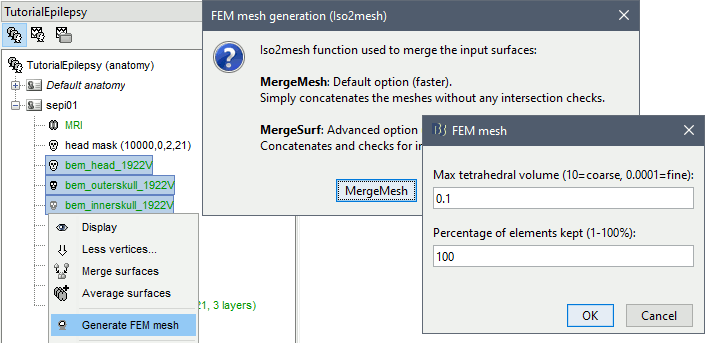
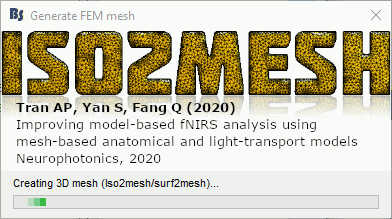
The FEM mesh appears in the database explorer after a short while. The first number indicates the number of vertices (i.e. nodes) of the tetrahedral mesh. To get the number of 3D elements (i.e. tetrahedrons) in this geometric model of the head: right-click on the file > File > View file contents. The structure of the file is describe in the tutorial FEM mesh generation.

Double-click on the FEM file to display it. From the Surface tab, you can change the resection locations by moving the bottom sliders, and you can control the display of each of the three layers individually. Click on the layer button in the toolbar, then adjust the color and transparency of the corresponding mesh. The figure below represents the FEM mesh in the center and the initial BEM layers on the right.
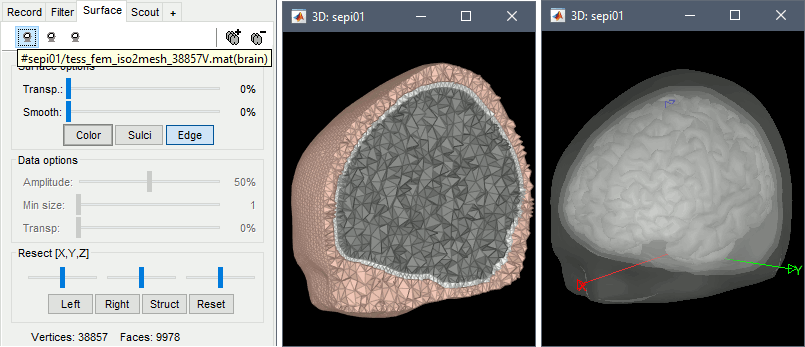
FEM forward model
The forward model (or head model in the Brainstorm documentation and interface) describes how the electric activity in the source space (the cortex surface or a regular grid of volume points) influences the electric potential (EEG) or magnetic fields (MEG) at the level of the sensors. The FEM method uses the tetrahedral mesh computed above to establish this relationship.
Go the Anatomy view. Select the default FEM mesh and cortex surface you'd like to use for the computation (in case there is more than one in each category). The selected elements appear in green, double-click or right-click > Set as default to change the selection.
Go to the Functional view. Right-click on the channel file > Compute head model.
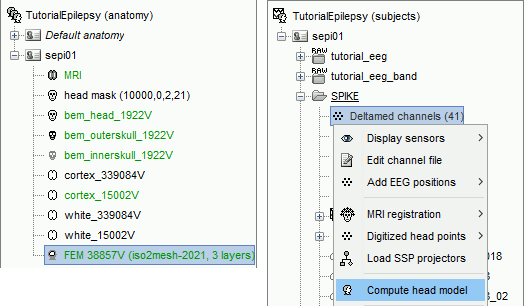
Select MRI volume, EEG: DUNEuro FEM, select all the layers and the default conductivity values (scalp = inside the head surface, skull = inside the outer skull surface, brain = inside the inner skull surface).
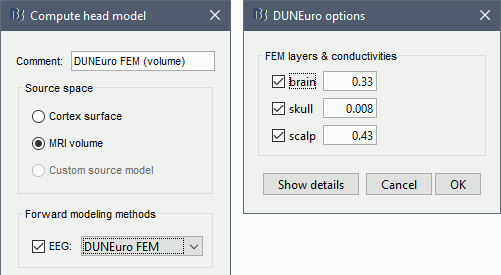
Volume source grid: Regular grid, brain, 5mm.
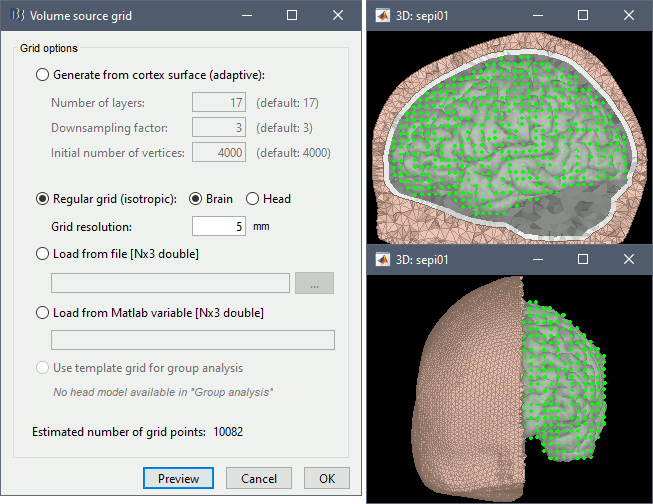
Start the computation. Depending on the complexity of the problem (number of FEM elements, number of layers, number of source points, number of sensors and computation options), this can take anywhere between a few minutes to a few days. In this example, if you selected the correct files and options, it should only take a few minutes. You may be prompted to download or update the bst-duneuro plugin.
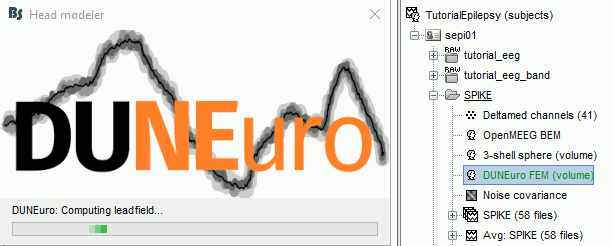
When it's finished, you have obtain a new head model, which can be used for source estimation: see the epilepsy tutorial, the volume source estimation tutorial, or the introduction tutorial.
DUNEuro options: Basic
When assuming isotropic conductivities for all the tissues, the DUNEuro basic options are limited to the selection of the tissues and their conductivities.
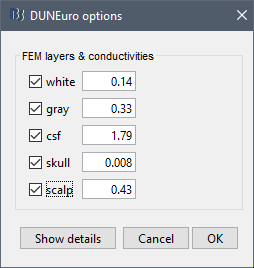
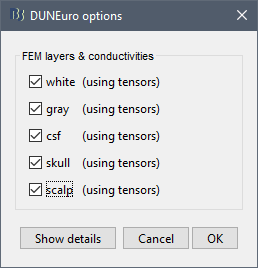
FEM layers: Brainstorm reads the lists of tissues from the selected FEM mesh. Users can select the desired layers to include in the FEM computation. According to the modalities, the recommended selections are:
EEG: Select all the layers
MEG: Select only the inner layers (inside the inner skull = brain = white+gray+csf)
SEEG: Select only the inner layers
ECOG: Select only the inner layers
- Any combination of modalities that includes MEG: select all the layers
FEM conductivities (isotropic): Left figure - Brainstorm proposes default conductivity values for each layer (derived from the SimBio software, see this article). However, you have the possibility to change these values according to your model.
FEM conductivities (anisotropic): Right figure - Advanced users can use information from diffusion imaging exams to estimate anisotropic conductivity tensors for each element of the FEM mesh. For more information, refer to the tutorial: FEM tensors estimation. To remove previously computed tensors and restore the default isotropic approach, right-click on the FEM mesh > Clear FEM tensors.
DUNEuro options: Advanced [TODO]
In the DUNEuro options panel, click on the button Show details to access the advanced options.
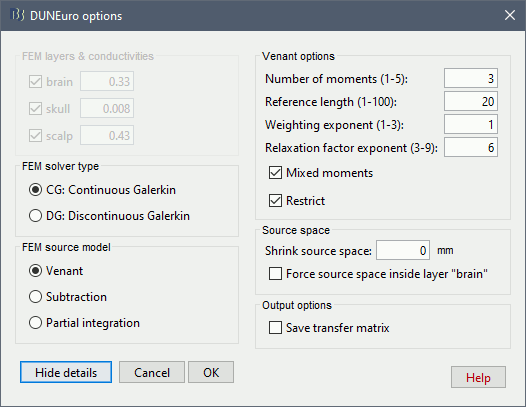
FEM layers & conductivities: Discussed in the previous section.
FEM solver type: (only the fitted FEM are integrated in Brainstorm at the moment)
CG: Continuous Galerkin: This is the standard Lagrangian method.
DC: Discontinuous Galerkin:
FEM source model:
Venant:
- Number of moments:
- Reference length:
- Weighting exponent:
- Relaxation factor exponent:
- Mixed moment:
- Restrict:
Subtraction:
- intorderadd:
- intorderadd_lb:
Partial integration:
Source space:
Shrink source space: The dipoles are moved inward by the specified distance (in mm).
Force source space: This is required when the dipoles are not within the gray matter.
Output options:
Save transfer matrix:
For more information about these methods, users can check Johannes Vorwerk's PhD thesis.
Troubleshooting [TODO]
DUNEuro binaries may crash for various reasons: we tried to list the possible causes here. Many FEM forward modeling issues are related with memory overload or extremely long computation times. Reducing the size of the problem may help in many cases. If you cannot find a solution, please post the full error message on the Brainstorm user forum (you can copy-paste the error message from the Matlab command window after closing the error message box).
Grid error messages
- Error message: Coordinate is outside of the grid, or grid is not convex
- Explanation: Some dipoles are probably outside of the cortex, users need to correct the source space.
- Solution: ?
Remove the neck
One way to reduce the size of the forward problem is to decrease the number of FEM elements in the head model. When the field of the MRI is large, you may have the mesh of the neck and even the shoulders. In most cases, it is safe to remove the lower part of the FEM mesh, below the nose and the brainstem. Right-click on the FEM mesh > Resect Neck.
Once the process is finished, a new FEM mesh appears in the database, with a tag "resect". The following figure shows the model before (743828 vertices / 4079587 elements) and after resection (613955 vertices / 3400957 elements). It will reduce the size of the problem by 20%.
Additional documentation
Related tutorials
DUNEuro references
DUNEuro wiki: https://gitlab.dune-project.org/duneuro/duneuro/wikis/home
DUNEuro website: https://www.medizin.uni-muenster.de/duneuro/startseite.html
List of the parameters: https://docs.google.com/spreadsheets/d/1MqURQsszn8Qj3-XRX_Z8qFFnz6Yl2-uYALkV-8pJVaM/edit#gid=0
Brainstorm-DUNEuro integration
Brainstorm user forum
Sources in white matter: https://neuroimage.usc.edu/forums/t/each-source-is-in-which-layer-of-the-mesh/31887/10
